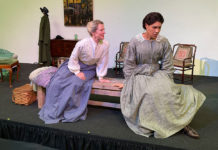Gardening after the world’s end
Well, the world didn’t end and gardening chores and planting still call to us! I’m so glad, as gardening and watching pollinators is a huge thrill for so many people. Did you know that you can still put out wildflower seeds and have a bountiful spring crop? Rather than using gravel in a low-water landscape, why not put in wildflowers? The bed must be free of weeds, plastic weed barrier and deep mulch.
A wildflower garden cannot be planted on deeply mulched beds, or into weedy, unprepared soil. Wildflowers cannot handle much competition from grasses, especially our non-native annual grasses. Before Europeans brought cattle and other livestock, along with their annual feed, California abounded in native bunch grasses, interspersed with millions of wildflowers.
Prepare the area, wet it down and rake in wildflower seeds. You might then cover the bed with rice (weed-free) straw, or branches and twigs, or even Remay (brand of floating row cover); anything to keep the birds from eating all the seeds. Your wildflowers will be swarming with bees and other pollinators in the spring.
One place to find bulk seeds is at LeBallisters in Santa Rosa. They carry about fifteen native seeds, including four native lupine seeds. They are sold in quarter-pound increments, averaging $12 to $17 per pound. Even a half-pound is a lot of seeds!
Phil Van Soelen of California Flora Nursery raves about his Chaparral currant, which is now in bloom and was throughout December. It is Ribes malvaceum, and because it blooms in the winter, is a favorite nectar source for hummingbirds. Our little Anna’s hummingbirds stay around all winter, in fact, they are permanent residents. One of their challenges is to find good nourishing sources of nectar, and we have so little blooming in the dark of winter. At times, the rosemarys are in bloom in winter. Many people put out a feeder in the winter; feeders must be kept clean of mildew.
The chaparral currant is a tough and resilient shrub from the coastal hills of the Bay Area and other places in California. Full sun or partial shade will suit it, and little water is needed, other than a bit in the summer to keep it from going dormant. Its pungent, gray-green leaves are deciduous. The flowers cluster together in fragrant pink to rose bouquets. Red berries come along later. Its height ranges from four to ten feet, the branches growing in a vase shape.
The other two native currants bloom in spring and are not quite as tolerant of hot sun or lack of water. They are beautiful also, with pendulous blossoms of roses, pinks and reds. The pink flowering currant (Ribes sanguineum var. glutinosum) and fuchsia flowered gooseberry (R. speciosum) are also deciduous and prefer some shade and water. The gooseberry is spiny, so locate it in an out-of-the-way area. They are hummingbird favorites; the berries are eaten by birds.
Need help with pruning? A three-hour workshop on fruit tree and vine pruning is available at Occidental Art & Ecology Center on Saturday, January 19. They will explore the basics and benefits of winter and summer pruning. It runs from 9 a.m. to noon and the fee is $35. There is a rain date of January 27. Go to www.oaec.org or call them at 874-1557, ext. 101.
Check out the new CNPS website: www.milobaker.cnps.org. And don’t miss their January, 2013 meeting on Tuesday, January 15. Betty Young will talk about how she and others saved the Manzanita franciscana, the last of the known plants of this species growing in the wild. It was found on the SF side of the Golden Gate Bridge, where construction was tearing up the roads. Meetings are at 7:30 p.m. at the Luther Burbank Art & Garden Center at 2050 Yulupa in Santa Rosa. Call Leia at 322-6722 for more information.
Here’s a good gardening website: www.davesgarden.com. It has lots of information, photos, tips etc. They had a photo contest and the resulting calendar for 2013 is on sale at their site.
Please write me at: jo*******@co*****.net.
48.9
F
Healdsburg
April 19, 2025







